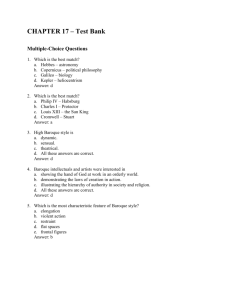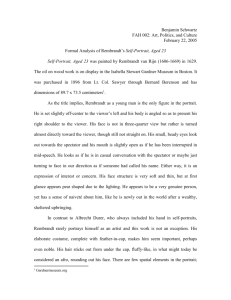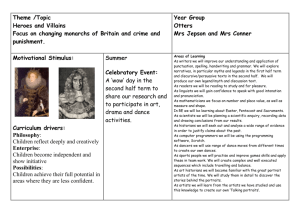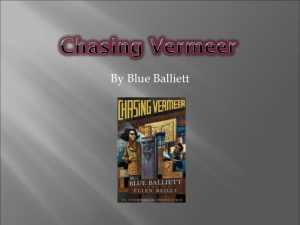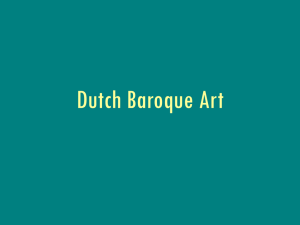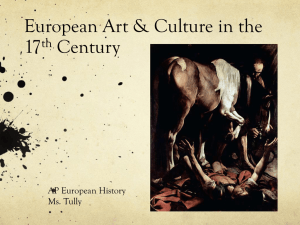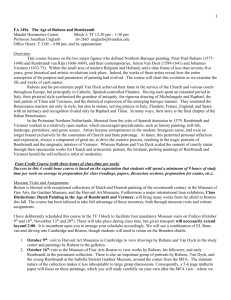MS Word - Department of Art History
advertisement
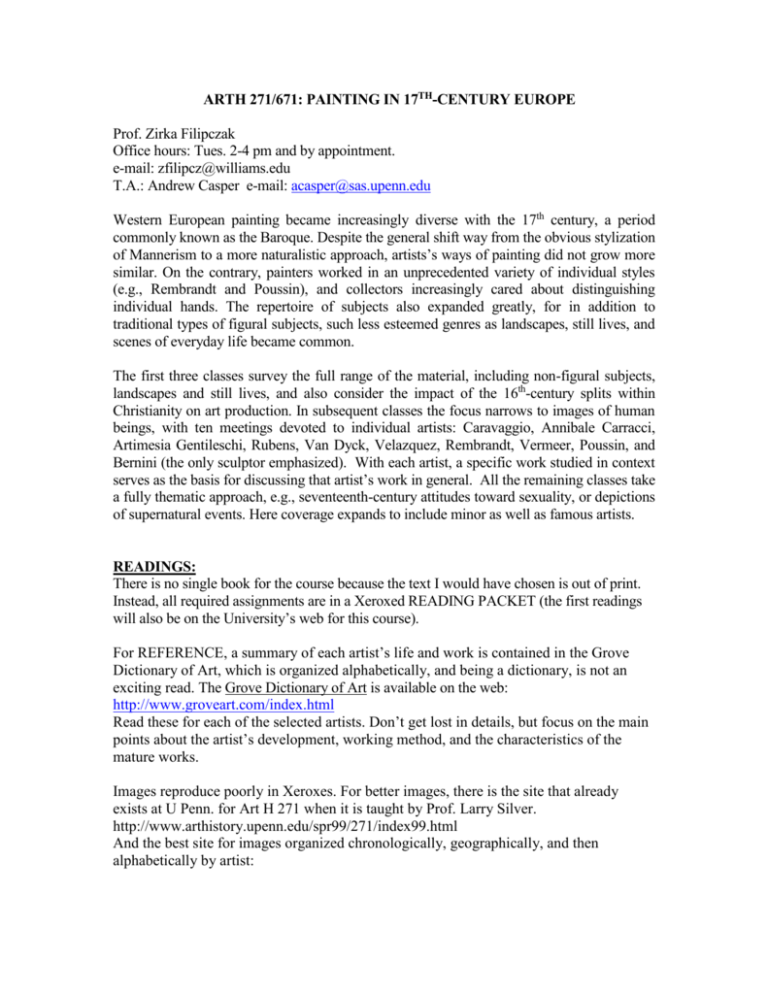
ARTH 271/671: PAINTING IN 17TH-CENTURY EUROPE Prof. Zirka Filipczak Office hours: Tues. 2-4 pm and by appointment. e-mail: zfilipcz@williams.edu T.A.: Andrew Casper e-mail: acasper@sas.upenn.edu Western European painting became increasingly diverse with the 17th century, a period commonly known as the Baroque. Despite the general shift way from the obvious stylization of Mannerism to a more naturalistic approach, artists’s ways of painting did not grow more similar. On the contrary, painters worked in an unprecedented variety of individual styles (e.g., Rembrandt and Poussin), and collectors increasingly cared about distinguishing individual hands. The repertoire of subjects also expanded greatly, for in addition to traditional types of figural subjects, such less esteemed genres as landscapes, still lives, and scenes of everyday life became common. The first three classes survey the full range of the material, including non-figural subjects, landscapes and still lives, and also consider the impact of the 16th-century splits within Christianity on art production. In subsequent classes the focus narrows to images of human beings, with ten meetings devoted to individual artists: Caravaggio, Annibale Carracci, Artimesia Gentileschi, Rubens, Van Dyck, Velazquez, Rembrandt, Vermeer, Poussin, and Bernini (the only sculptor emphasized). With each artist, a specific work studied in context serves as the basis for discussing that artist’s work in general. All the remaining classes take a fully thematic approach, e.g., seventeenth-century attitudes toward sexuality, or depictions of supernatural events. Here coverage expands to include minor as well as famous artists. READINGS: There is no single book for the course because the text I would have chosen is out of print. Instead, all required assignments are in a Xeroxed READING PACKET (the first readings will also be on the University’s web for this course). For REFERENCE, a summary of each artist’s life and work is contained in the Grove Dictionary of Art, which is organized alphabetically, and being a dictionary, is not an exciting read. The Grove Dictionary of Art is available on the web: http://www.groveart.com/index.html Read these for each of the selected artists. Don’t get lost in details, but focus on the main points about the artist’s development, working method, and the characteristics of the mature works. Images reproduce poorly in Xeroxes. For better images, there is the site that already exists at U Penn. for Art H 271 when it is taught by Prof. Larry Silver. http://www.arthistory.upenn.edu/spr99/271/index99.html And the best site for images organized chronologically, geographically, and then alphabetically by artist: http://witcombe.sbc.edu/ARTHbaroque.html It also contains links to other sites. REQUIREMENTS: Midterm and final. There will be a prepared essay (i.e., an essay for which the question is distributed well before the exam) on both exams. Paper 5 page paper on a 17th-century work in the Philadelphia Museum of Art. Due Oct. 15 in class. A couple of questions With your paper, submit 2 real questions about any of the readings assigned up to Oct. 15. By that I mean questions to which you would genuinely like an answer and one is not to be found in our reading materials. If clear enough, each question can be as short as a sentence, but it should not be longer than a paragraph. These should not be questions with a yes or no answer, or ones about very specific historical information that may not be available (e.g., who commissioned a specific work?). The 2 questions will be graded separately from the paper (high pass, pass, perfunctory pass, fail. If your final average hovers between grades, a high pass will shift your final grade up, a perfunctory pass or fail will shift it down.) CLASS SCHEDULE September 5 and 10: OVERVIEW Reading: Heinrich Woelfflin from Principles of Art History, 1915 John Rupert Martin, “The Baroque from the Point of View of the Art Historian” 1955 Julius Held and Donald Posner (Xerox) from 17th and 18th Century Art, 1971 Sept. 12 : NATURALISM AND ALLEGORY Some works are overtly allegorical, some may depict scenes based on ones that actually existed, and some combine these approaches. Deciding which ones do has been controversial. Reading: John Rupert Martin, from Baroque, 1975 Bob Haak, from The Golden Age , 1984 E. de Jongh, “A bird’s-eye view of erotica”(originally publ. 1969). from Questions of Meaning, 2000 Sept. 17: ANNIBALE CARRACCI (ITALIAN, 1560-1609) On a ceiling in a cardinal’s palace in Rome Annibale Carracci painted the loves of the gods. Visually complex in its levels of illusionism, the ceiling has also been variously interpreted.. Reading: Charles Dempsey, from Annibale Carracci. The Farnese Gallery John Rupert Martin, from The Farnese Gallery Sept. 19 MICHELANGELO DEL CARAVAGGIO (ITALIAN, 1571-1610) One of Caravaggio’s most reproduced works is The Supper at Emmaus (London, National Gallery. He returned to the subject later (Milan, Brera). Why did this subject become more popular in the 17th century than the Last Supper, which had been the more popular subject in the Renaissance? And why focus on this question with Caravaggio? Reading about a late painting with an unexpected signature:: Howard Hibbard from Caravaggio, 1983 Helen Langdon from Caravaggio. A Life, 1998 Catherine Puglisi from Michelangelo Merisi da Caravaggio, 1998 Sept. 24: ARTIMESIA GENTILESCHI (ITALIAN, c.1597 –c.1652) She has been the subject of considerable popular attention lately, in part because some art historians have interpreted her as a proto-feminist. How well does this characterization apply to her works? Reading: Mary Garrard from Artemesia, 1989 Ward Bissell from Artemisia Gentileschi, 19999 Sept. 26: PETER PAUL RUBENS (FLEMISH, 1577-1640) How was Rubens able to produce such a huge number of works, many of them overlifesized, and how did he make the idealized scenes persuasive to viewers? Reading: Ruth Magurn from The Letters of Peter Paul Rubens, 1955 Julius Held, from The Oil Sketches of Peter Paul Rubens Oct.1: ANTHONY VAN DYCK (FLEMISH, 1599-1641) Van Dyck’s portraits changed not only in the course of his career but also in response to difference social conditions in the Southern Netherlands, Italy, and England. Reading: Julius S. Held, ”Le Roi a la Ciasse,” originally Art Bulletin 1958 Oct. 3: DIEGO VELAZQUEZ (SPANISH, 1599-1660) Las Meninas (Madrid, Prado), the most famous and elusive Spanish painting of the 17th century, is simultaneously a group portrait, a genre scene, and an allegory about art. What role did it play in Velazquez’s attempts to raise his social status?. Reading: Jonathan Brown from Images and Ideas in Seventeenth-Century Spanish Painting, 1978 Joel Snyder and Ted Cohen, “Reflexions on Las Meninas: Paradox Lost,” Critical Inquiry 1980 Nanette Salomon, “ A Woman’s Place: The Queen in Las Maninas,” Source, 1986 Oct. 8: REMBRANDT VAN RIJN (DUTCH, 1606-69) In depicting emotions, did Rembrandt rely just on the western tradition of expressing the “passions of the soul” through pose and facial expression? Reading: Julius Held, “Rembrandt and the Spoken Word” (originally publ. 1970), from Rembrandt Studies 1991 Oct. 10: JAN VERMEER (DUTCH, 1632-75) Is there any relationship between Vermeer’s typical choice of a woman as his main subject and his probable use of a viewing device, the camera obscura? Reading: Arthur Wheelock from Vermeer and the Art of Painting 1995 Daniel Arasse from Vermeer. Faith in Painting 1994 Paper due Oct. 15, in class. Oct. 15: NICOLAS POUSSIN (FRENCH LIVING IN ITALY 1593/4-1665) Is Poussin’s position that different subjects “require a different treatment” evident in his works? Reading: Letter by Poussin from Anthony Blunt, Nicolas Poussin 1985 Elizabeth Cropper and Charles Dempsey from Nicholas Poussin 1996 Oct. 17: BERNINI (ITALIAN 1598-1680) Which of the devices that Benini uses to stage the supernatural event in The Ecstasy of St. Teresa does he also use for other works? Reading: Irving Lavin fromBernini and the Unity of the Visual Arts Oct. 22: MIDTERM Oct. 24: TWO THEORIES ABOUT 17-CENT. ATTITUDES TO SEXUALITY Did attitudes towards sexuality become more represeed with the 17th century. Test two different interpretations. Reading: Norbert Elias, from The History of Manners 1939 Michel Foucault, from The History of Sexuality 1976 James Saslow, from Ganymede in the Renaissance Oct. 29: HOT DRY MEN, COLD WET WOMEN. Artists and their contemporaries accepted that humoral differences were the biological basis for sexual (and what we call gender) differences. Did their shared belief in this classical theory influence their choice and interpretation of subjects. Reading: Ian Maclean from The Renaissance Notion of Woman 1980 Oct. 31: CONVENTIONAL POSES AND GESTURES AND THEIR IMPLICATIONS How people moved and arranged their bodies was partly the product of social expectations, which were not the same for different classes, or women as for men Which poses meant what to contemporaries? Reading: Herman Roodenberg, “How to Sit, Stand and Walk”(originally publ.1993) from Looking at Dutch Art, ed. W. Franits Joaneath Spicer, "Jaunty Soldiers and Good Husbands" from The Walters 1990 Nov. 5: BODIES RESHAPED BY CLOTHING When fashionably dressed, 17th-century women and men looked far more different, even at a distance, than when naked. What were the implications of their clothing? Reading: Philip Aries from Centuries of Childhood Ann Hollander from Seeing through Clothing Nov. 7: ART IN THE SERVICE OF RELIGION In Catholic countries artists continued to receive numerous commissions for altarpieces which now, however, often reaffirmed positions denied by Protestants. Reading: Emile Male from Religious Art Zirka Filipczak, "A Time Fertile in Miracles" from The Age of the Marvelous ed. Joy Kenseth Nov. 12: MIRACLES AND WITCHCRAFT Were witches depicted as the evil opposite of saints in the 17th-century, as has been said about the way they were characterized in the late middle ages? Reading: Jane Davidson from The Witch in Northern European Art, 1987 Nov.14: METAMORPHOSES OF HUMANS INTO PLANTS AND ANIMALS The metamorphoses described in classical myths, especially in Ovid’s Metamorphoses, were comparable to miracles in Christianity in that they took brought about a supernatural transformation. Reading. Does viewing position affect perception of meaning? Howard Hibbard from Bernini 1965 Joy Kenseth, “Bernini’s Borghese Sculptures. Another View” from Art Bulletin, June 1991 Nov.19: OTHER MYTHS Nov. 21: GROUP PORTRAITS Portraits of people in groups posed special problems that artists solved through a combination of conventional and innovative means. Reading: Mariet Westermann, “Portraiture and the Identity of Self and Community,” from A Worldly Art. The Dutch Republic, 1996 Nov. 26 INDIVIDUAL PORTRAITS. LECTURE BY ANDREW CASPER Emphasis on individual portraits by Rembrandt Looking: For class, look at portraits by Rembrandt and by other artists, especially Frans Hals, who was also Dutch, and try to gauge where Rembrandt follows convention and where he innovates Dec. 3: ART ABOUT ART Most artists left no writings about art (and probably never produced such) but many produced images that refer to their own profession. Reading: Victor Stoichita, from The Self-Aware Image 1997 Dec. 5 ART ABOUT ART CONT’D. SELF-PORTRAITS. AND FINAL THOUGHTS ABOUT THE COURSE MATERIAL. Reading: Mariet Westermann, “Artistic Authority,” from A Worldly Art. The Dutch Republic, 1996


